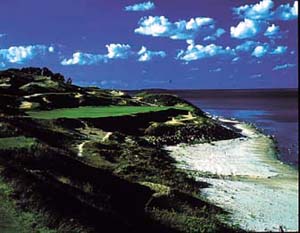
The 2004 PGA Championship
will be played in the Straits
layout of sane dunes, bunkers, wasteland and water,
much of which is evident on the seventh hole
Wisconsin
Think water, not cheese, as in
the golf course hazards
By Bill F. Hensley
Before a recent visit to the state, whenever I
thought of Wisconsin I thought of dairy products, bratwurst, beer,
Harley-Davidson motorcycles, badgers and the Green Bay Packers.
Now I first think of water. Thatís because the state is bordered on
the east by Lake Michigan, on the northwest by Lake Superior, and on
the west by the Mississippi River. Whatís more, there are more than
14,000 named lakes in the state.
My interest was piqued at the U.S. Womenís Open in Southern Pines in
June. With play suspended by rain, conversation in the media room was
about golf, naturally, and the writers from around the world talked
about some of their favorite courses. The relatively new Whistling
Straits and Blackwolf Run courses in Kohler, an hour north of
Milwaukee on the shores of Lake Michigan, made the lists of several.
I was intrigued and called longtime friend Gary Knowles in Madison, a
former state tourism promoter who now has his own public relations
firm. ďSure, Iíll plan a sampling of golf for you,Ē he said.
ďCome on up. Iíll even join you for a few days.Ē
Our trip began in Wisconsin Rapids, a bustling spot in the center of
the state along the Wisconsin River. This is cranberry country, folks,
and when visitors arenít playing golf or engaged in water sports,
they drive the Cranberry Highway and visit the many berry farms along
the way that make the state the nationís leading producer.
Headquarters was the renowned Mead Hotel in the center of town, a
popular hostelry that features two gourmet restaurants. Time didnít
permit a game, so we rode golf carts around the Ridges for a quick
view of the in-town golf course that is a haven for locals and
visitors alike ó one of more than 400 in the state available to the
public.
Twenty miles south of town on Highway 13, our golf began at Lake
Arrowhead, a rolling 36-hole layout that offers two well-designed
courses. We played nine holes on each course, The Lakes and The Pines,
and were impressed with the superb conditions.
The next day we drove for an hour to Green Lake, which is west of Fond
du Lac. The road into town quickly revealed what was ahead in this
quaint, picturesque village of mostly summer homes around a large
lake. The architecture, from Victorian to Georgian, was displayed in a
wide variety of homes that ranged from modest to elegant.
The place to stay is the prestigious Heidel House, a classy lakeshore
hotel that is reminiscent of a bygone era where food, service and
hospitality reign supreme. After an outdoor lunch at the Boat House,
we headed for Lawsonia, a 36-hole golf complex, where we enjoyed The
Links Course.
The next stop ó a one-hour drive away ó was what I had really come
to see. The small town of Kohler, with a population of fewer than
2,000, is just a few good three-wood shots north of Sheboygan. It is
named for the nationally known manufacturer of bathroom fixtures, and
the Kohler family owns the famed American Club (one of the Midwestís
few Five Diamond resorts), the four Pete Dye-designed golf courses and
almost everything else.
The American Club is a 236-room luxury resort that was built in 1918
to house Kohlerís immigrant workers. It was converted into a hotel
in 1981, and the golf courses and spa soon followed.
Ten miles north of the resort on a bluff overlooking Lake Michigan,
Whistling Straits has two courses, the Straits and the Irish. The 2004
PGA Championship will be played on the intriguing Straits layout of
sand dunes, bunkers, wasteland, yawning canyons and water. A stiff
wind prevails. Think Ireland and Ballybunnion on this walking-only
course that is served by approximately 250 caddies. The Irish course,
where carts are permitted, is awesome but less severe.
A mile south of the American Club, another treacherous 36-hole Dye
creation awaits along the Sheboygan River. This is Blackwolf Run and
its River and Valley courses, where the 1998 U.S. Womenís Open was
held. Again, think difficult and challenging with higher scores than
you would like, yet an unforgettable experience.
Greens fees, like the wind, are a bit stiff, but your dollars buy a
memorable round to be talked about for years. Packages are available.
There is a lot to like about Wisconsin. Only my dwindled supply of
golf balls would disagree.
Return to magazine index
|
|

